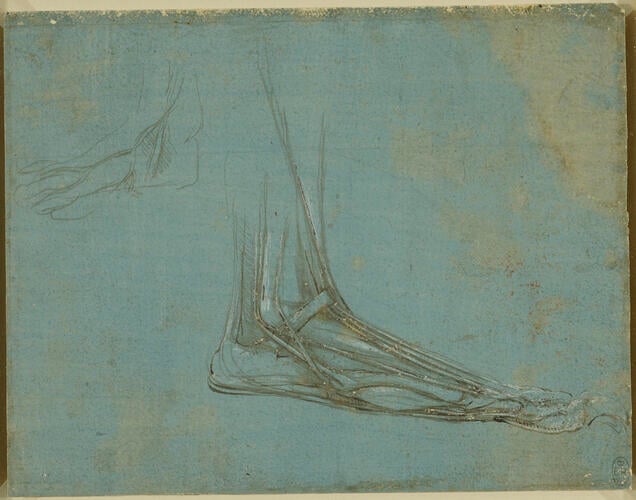-
1 of 253523 objects
A bear's foot c.1488-90
Metalpoint with pen and ink and white heightening, on blue-grey prepared paper | 14.1 x 18.1 cm (sheet of paper) | RCIN 912374
-
During the latter part of the 1480s, Leonardo dissected the left hind leg of a bear. At that time bears were common in the mountains of Italy; they were hunted for sport and kept in captivity for entertainment, and Leonardo could thus easily have obtained a specimen for dissection. His particular interest in the animal was probably due to its plantigrade gait – like humans, bears walk with their feet flat on the ground (digitigrade animals such as dogs and cats walk on some portion of the digits, and unguligrade animals such as horses or cattle walk on the tip of a digit, usually in the form of a hoof). Leonardo’s dissection would therefore have given him an insight into the anatomy of the human foot at a time when he had little access to human material.
The principal drawing shows the bones, muscles and tendons of the lower leg and foot of a bear, in a medial or inside view. As with RCIN 912372-3 (qv for a full discussion of the anatomy), the extensor retinaculum ligament is holding in place the tendons of extensor digitorum longus on the front surface of the ankle. The unfinished sketch appears to show the vessels of the upper surface of the foot.
Text adapted from M. Clayton and R. Philo, Leonardo da Vinci: Anatomist, London 2012, no. 10Provenance
Bequeathed to Francesco Melzi; from whose heirs purchased by Pompeo Leoni, c.1582-90; Thomas Howard, 14th Earl of Arundel, by 1630; Probably acquired by Charles II; Royal Collection by 1690
-
Creator(s)
Acquirer(s)
-
Medium and techniques
Metalpoint with pen and ink and white heightening, on blue-grey prepared paper
Measurements
14.1 x 18.1 cm (sheet of paper)
Other number(s)
